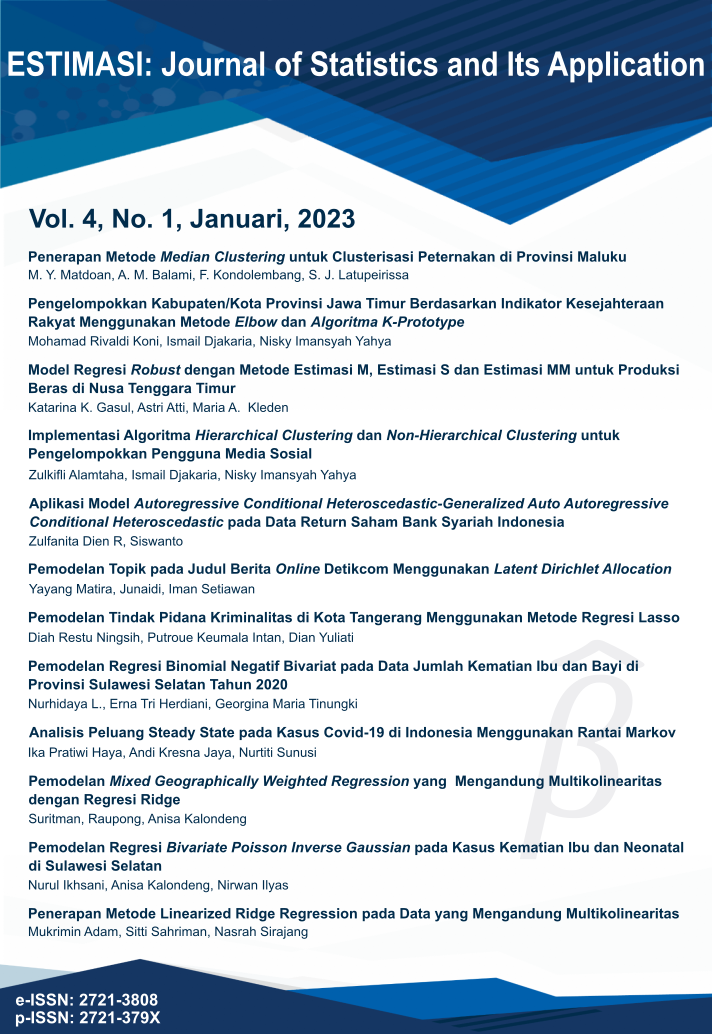Analisis Peluang Steady State Pada Kasus Covid-19 di Indonesia Menggunakan Rantai Markov
DOI:
https://doi.org/10.20956/ejsa.vi.24802Keywords:
Covid-19, Increase of Positive Cases Covid-19, Markov Chain, Prediction, StationaryAbstract
Covid-19 in Indonesia began to be recorded on March 2, 2020 with the number of positive patient cases as many as 2 people with the passage of time Covid-19 cases in Indonesia are always increasing. To see the development of Covid-19 cases in the future period, the opportunity for the number of Covid-19 cases can be used using the Markov chain. The Markov chain method is carried out using a transition probability matrix which is seen from the number of additions to positive Covid-19 patients in a steady state or a situation for a long period of time. Based on the results of the range of additions to the number of positive cases of Covid-19, 6 states were used. Furthermore, the calculation of the Markov Chain in the stationary state of Covid-19 cases in Indonesia after 328 days or 11 months obtained the probability of each state, namely state 1 of 0.0005, state 2 of 0.0069, state 3 of 0.1707, state 4 of 0.1462, state 5 of 0.1884 , and state 6 is 0.4873. Prediction of the addition of positive Covid-19 patients obtained results as many as 2058 patients in state 5 for July 1, 2022 with actual data as many as 2049 patients.
References
Anton H., Rorres C. (2005). Aljabar Linear Elementer. Jakarta: Erlangga.
Aritonang, K., dkk. (2020). Analisis Penambahan Pasien COVID-19 di Indonesia Menggunakan Metode Rantai Markov. Jurnal Rekayasa Sistem Industri, 9(2), 69-76.
Bustan, M. N., dkk. Analisis Peluang Penyebaran Covid-19 Menggunakan Rantai Markov Di Sulawesi Selatan. VARIANSI: Journal of Statistics and Its application on Teaching and Research, 3(2), 102-110.
Langi, Y. A. (2011). Penentuan Klasifikasi State pada Rantai Markov dengan Menggunakan Nilai Eigen dari Matriks Peluang Transisi. Jurnal Ilmiah Sains, 11(1), 124-130.
Novianti, A., dkk. (2021). Analisis Peluang Naiknya Kasus COVID-19 Provinsi di Pulau Jawa dengan Pendekatan Rantai Markov. Jurnal Statistika dan Aplikasinya, 5(2), 230-242.
Pishro-Nik, H. (2016). Introduction to probability, statistics, and random processes.
Ross, S. M. (2010). Introduction to Probability Models 10th edition Academic Press.
Rosyidi, dkk. (2012). Analisis loyalitas merek pada produk sepeda motor menggunakan markov chains. Inasea, 13(1), 62-63.
Downloads
Published
Issue
Section
License
Copyright
It is the author's responsibility to ensure that his or her submitted work does not infringe any existing copyright. Authors should obtain permission to reproduce or adapt copyrighted material and provide evidence of approval upon submitting the final version of a manuscript.


